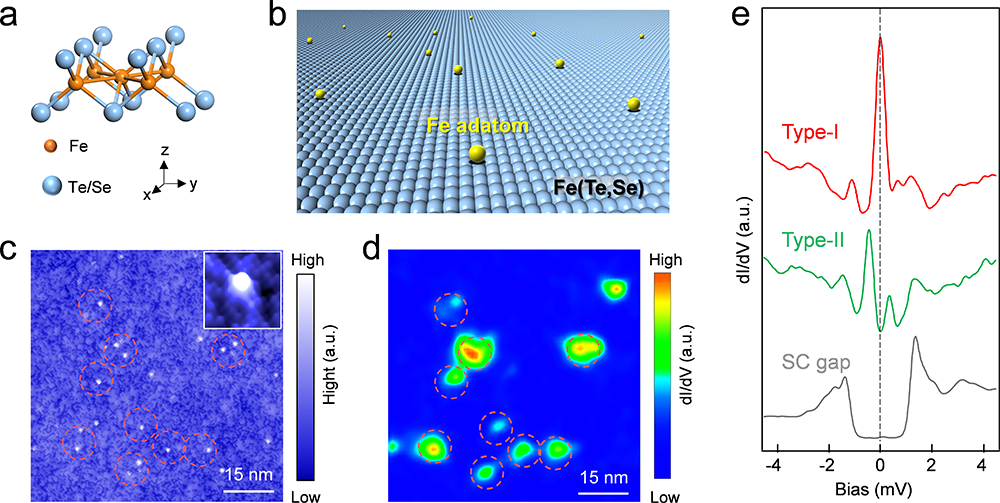Reversible transition between Yu-Shiba-Rusinov state and Majorana zero mode in an iron-based superconductor
Date:18-03-2021 Print
Majorana fermion is the particle whose antiparticle is itself. Searching for Majorana fermion is one of the most important research in high energy physics. However, there is no solid evidence about the existence of this kind of real particle. In condensed matters, there is a quasiparticle which is always bounding with topological defect. Since the creation and annihilation operators of this quasiparticle are self-conjugation operator, the quasiparticle is called Majorana zero mode (MZM). MZMs obey the non-Abel statistics. Braiding MZMs is one of the routes to carry out the fault-tolerant topological quantum computing.
Professor Gao’s group and Professor Ding’s group have been cooperating together to study iron-based superconductor since 2017. They study MZM by using scanning tunneling microscopes (STM). They observed pure MZM in the vortex on the surface of FeTe0.55Se0.45 for the first time at 2017 (D. Wang et al., Science 362, 333 (2018)). This result has been repeated by several groups in Fudan U., U. of Illinois, Nanjing U. and so on. Then, they carried out further study aimed at the phenomenon that some vortex may not host MZMs. The inhomogeneity of the chemical potential of FeTe0.55Se0.45 breaks the strong topological bulk state in same area, which leads to the absence of topological surface states (L. Kong et al., Nat. Phys. 15, 1181 (2019)). In addition, they observed nearly quantized Majorana conductance plateau in the vortex in FeTe0.55Se0.45, which is a compellent evidence for the existence of MZM (S. Zhu et al., Science 367, 189 (2020)). They also observed MZM in the vortex in CaKFe4As4 single crystal, which expands the study of MZM to iron-phosphorus-based superconductors (W. Liu et al., Nat. Commun. 11, 5688 (2020)).
This Majorana platform also presents new challenges for the basic understanding of defect excitations in superconductors with a topological nontrivial band structure, and new possibilities for creating MZMs under different physical conditions. In general, superconductors can host two kinds of defect excitations as in-gap bound states: the YSR states localized at a magnetic impurity and the Caroli-de-Gennes-Matricon (CdGM) states inside a magnetic vortex core. Jiaxin Yin et al. studied Fe1+x(Te, Se) under the guidance of Professor Suhen Pan and Professor Hong Ding (J. Yin et al., Nature Phys. 11, 543 (2015)). They observed a robust ZBP at interstitial Fe atoms. But there has been a lack of further understanding of this ZBP. Recently, a theory work (Phys. Rev. X 9, 011033 (2019)) proposed that a quantum anomalous vortex (QAV) can be induced near the Fe atom located at C4 symmetric site when the exchange coupling is strong enough. The role of the magnetic field is played by the exchange coupling of the spin and orbital moment of the Fe impurity located at the C4 symmetric sites, which generates circulating supercurrents by the spin-orbit coupling and modulates the phase of the superconducting order parameter. An MZM emerges inside the QAV core from the superconducting TSS, since the Berry phase of the Dirac fermions transforms the total angular momentum quantum number of the CdGM vortex core states into integers.
Recently, Professor Gao’s group (Peng Fan, Guojian Qian, Hui Chen et al.) and Professor Ding’s group (Fazhi Yang et al.) cooperated with Professor Wang. They studied the bound states on single Fe adatom on the surface of FeTe0.55Se0.45. They observed both YSR states and zero bias peak (ZBP) (Fig. 1). The ZBP, which is always coexisted with in-gap states with integer energy level spacing, doesn’t shift or split when crossing the Fe adatom (Fig. 2). This result conforms the property that the CdGM states have integer energy level spacing in the topological vortex in the quantum limit. In addition, the ZBP disappears at 4 K, which is the same as the behavior of MZM in magnetic field-induced vortex (Fig. 2). The ZBP does not split under a very high magnetic field (8 T) (Fig. 2). All the results provide compelling evidences to the existence of QAV and MZM in QAV.
Furthermore, they manipulated the exchange coupling between Fe adatom and substrate by changing the position between the STM tip and Fe adatom. The change of the exchange coupling leads to the reversible transition between YSR states and MZM. In addition, they observed the hybridization between the MZMs in QAV and field induced-vortex.
The study on magnetic Fe adatoms deposited on the surface of FeTe0.55Se0.45 superconductors revealed the spontaneous formation of anomalous vortex matter with integer quantized core states and MZMs in zero external field, and the reversible transition between the YSR impurity and the QAV with increasing exchange interaction strength. Together with the observed fusion hybridization of the MZMs in the QAV nucleated at the Fe adatom and the nearby field-induced Abrikosov vortex, these findings provide compelling evidences to the existence of QAV and MZM.
This research paves a new path to study the interaction and braiding of MZMs. The results have been published on line in Nature Communications (Nat. Commun. 12, 1348 (2021)). Peng Fan, Fazhi Yang, Guojian Qian and Hui Chen contributed equally to this work. Hong-Jun Gao, Ziqiang Wang and Hong Ding are corresponding authors. The work at IOP is supported by grants from the National Natural Science Foundation of China (11888101, 61888102, 52022105 and 11674371), the National Key Research and Development Projects of China (2016YFA0202300, 2018YFA0305800 and 2019YFA0308500), and the Chinese Academy of Sciences (XDB28000000, XDB07000000, 112111KYSB20160061).
Link of the article:
https://www.nature.com/articles/s41467-021-21646-x

Fig. 1 Characterization of deposited Fe adatoms on FeTe0.55Se0.45 surface.

Fig. 2 ZBP and integer quantized in-gap states on type-I Fe adatoms.

Fig. 3 Reversible transitions between YSR states and a robust ZBP/MZM induced by modulating the exchange coupling of type-II Fe adatoms using the STM tip.

Fig. 4 Hybridization between two MZMs in the QAV and field-induced vortex.


